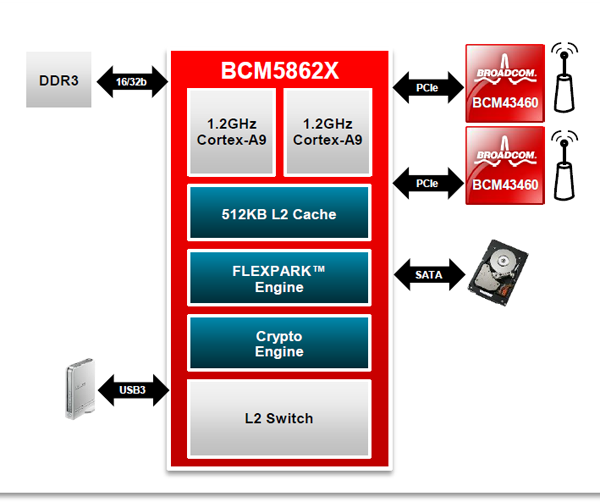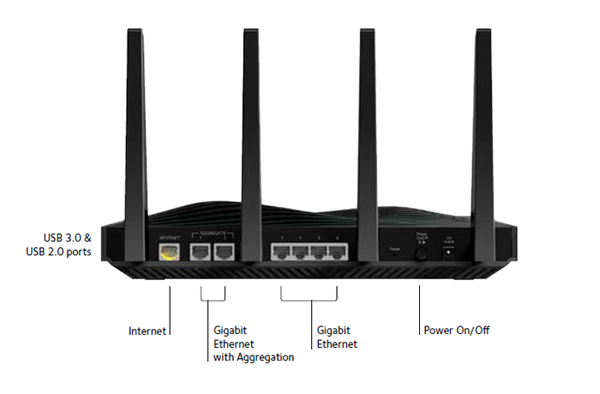Router SoC 101
Do you ever wonder what goes on inside a router? In this article, we take a close look at the SoCs inside of them, which help us manage and maintain our connected lives.
Chipset Vendors: Broadcom
Broadcom is the wireless and broadband component manufacturing industry's leader. Its undisputed strength lies in its transceivers and radios, which are even used in conjunction with competing router SoCs.
Broadcom Router SoCs
Introduced in 2013, the StrataGX BCM5862X series is part of Broadcom’s Northstar Plus family, featuring single- or dual-core ARM Cortex-A9 processors at 1.2GHz. They connect to two transceivers via PCIe, and are designed for 5G Wi-Fi in combination with capable transceivers. With two SATA 6Gb/s interfaces, a cryptographic accelerator and fast memory, the BCM5862X series is intended for storage appliances.
The BCM5301x and BCM470X lines brought 802.11ac-specific support to the Broadcom portfolio in 2012. The 5301x is the enterprise/small business version of the 470x series suitable for residential routers and gateways, and both are manufactured on a 40nm processes. The 4709/AO/CO chips succeeded the popular 4708 series; the AO model was released in 2013, followed by a base model in 2014. The newest member of the family, the BCM4709CO, came out in 2015 (and is also listed as the BCM47094).
Broadcom's latest and greatest for "affordable and mid-tier" residential/small-business routers, the BCM47189 and the BCM53573, were introduced in January 2015 at CES. They are (probably) meant to be paired with the BCM4366 5G Wi-Fi 4x4 MU-MIMO transceiver (radio) chip. Broadcom also announced its enterprise- and cloud-oriented SoCs from the same family, the 43465/43525 and the 47452.
| Model Number | Year | Processor Specs | Wireless Specs | Additional Capabilities | Used In |
|---|---|---|---|---|---|
| BCM5862X Series | 2013 | Dual-core 1.2GHz ARM Cortex-A9 | 2xPCIe slots5G Wi-Fi readyDesigned for 2xBCM43460 transceivers | Programmable packet accelerator that offloads tasks from the main CPU cores, with local memory.Support up to DDR3-1600 memory (16-bit for the 58622 and 58623, 32-bit for 58625).Twin 2.5G SATA 6Gb/s interfacesCrypto accelerator | Unknown as of yet |
| BCM4709COBCM47094 | 2015 | Dual-core 1.4GHz ARM Corex-A9 | 3xPCIe slots for Tri-Band (Xstream)Designed for 3xBCM4366 4x4 radios | Network hardware acceleration, Layer 2 switch and flow controlIntegrated 5 port 10/100/1000 BASE-TX Ethernet transceiversUSB 3.0, offering >100MB/s data ratesRGMII expander ports | Asus RT-AC3100, RT-AC5300, RT-AC88UNetgear R8500D-Link DIR-885L |
| BCM47189BCM53573 | 2015 | “High Performance” ARM CPU | Simultaneous dual-band 2x2/1+1 5G Wi-Fi | RGMII to enable GbEiPA and ePA support | Unknown as of yet |
| BCM63138 | 2015 | Dual-core 1GHz ARM Cortex-A9 | None Inherent | Integrated ADSL/VDSL/Vectoring G.fast DSL modem + home-gatewayData rates “in excess of” 1 Gb/s with a 106MHz spectrum | Actiontec R3000 Netgear D7000 |
| BCM6318 | 2013 | 333MHz Single-core BMIPS3300 | Wi-Fi-capable | 4x Ethernet, 1x USB 2.0 ports | Huawei HG532dTP-Link Archer D7 v1.xTP-Link Archer D9 v1.xTP-Link TD-W8960N v5.x |
| BCM63268BCM63168 | 2012 | MIPS 400MHz | Integrated 802.11n radioBCM63268 designed to pair with BCM2057 radioBCM63168 designed to pair with BCM4360 transceiver (5G WiFi) | BCM63168 has VoIP supportGbE switch core3x FE PHY, 1x GE PHYCrypto accelerator | D-Link DSL-6740B rev C2Comtrend VR-3031uHuawei HG658Netgear D6400Various Others |
| BCM4706 | 2011 | MIPS 74Kc 600MHz | Dual PCIe SlotsDesigned to pair with BCM4331 transceiver (802.11n 3x3) | Integrated GbE, Integrated 512KB Fast Net RAMUSB 2.0 | Asus RT-AC66UD-Link DIR-865LLinksys EA6500 Netgear R6300 Netgear WNDR4500Western Digital My Net AC BridgeVarious Others |
An ADSL router SoC, the BCM6318 is designed for integration with entry-level networking devices, providing an all-in-one solution for turnkey router development.
Another integrated modem/router solution with an external wireless NIC, the BCM63268, is one of the most widely used chips for xDSL platforms. It is designed to work in conjunction with the BCM2057 radio. The 63168 provides VoIP support (multi-channel HD voice) and is designed for use with the BCM4360 5G Wi-Fi transceiver.
The BCM4706 sits right at the edge of obsolescence, but a number of popular, low-end routers from 2012 and 2013 use this chipset. Its dual PCIe interfaces are designed to pair with a BCM4331 802.11n 3x3 Wi-Fi transceiver, and it operates both in selectable and simultaneous dual-band configurations.
Get Tom's Hardware's best news and in-depth reviews, straight to your inbox.
Broadcom Transceivers
The BCM4352, BCM4360, BCM43526 and BCM43516 were a family of Gigabit 5G chips introduced in 2012 meant for the consumer market. They differ mostly in nominal speeds; the BCM4360 is the fastest, at 1.3 Gb/s via three streams, the BCM4352 and BCM43526 offer two streams at 867 Mb/s and the BCM43516 comes in last, providing 433 Mb/s. The BCM43526 comes with USB instead of a PCIe interface and targets set-top boxes and televisions. The BCM4360 is widely used in wireless routers like Asus' RT-AC56S and RT-AC56U; D-Link's DIR-860L; Linksys' EA6200, EA6300 and EA6350; and Netgear's D6200, EX6200 and R6200, among others.
The BCM43131 is a Wi-Fi chipset from 2013 with PCIe interface and support for Wi-Fi standards 802.11b, 802.11g and 802.11n. Equipped with a BCM2057 radio chip, it is used in wireless routers from Tenda, namely the D152, W150D v6 and W311E.
An earlier incarnation of this chipset, the BCM43217 (2012) is equipped with the BCM2055 radio, and supports b/g/n. It was used in wireless routers from a number of vendors, including Asus' RT-AC56S and –U; Belkin's F9K1113 and 1118; Linksys' EA6200, EA6300, EA6350 and EA6400; and Netgear's DGN2200, R6200 and R6250.
Introduced in 2014 as a 3x3 MIMO 802.11ac chip for routers, the BCM43602 is equipped with a 320MHz single-core processor and comes with a PCIe interface. Broadcom rates its peak performance at 900 Mb/s. The chip has been used in multiple routers, including Asus' RT-AC3200; the Linksys EA9200; Netgear's D7000 and R8000; and the TP-Link Archer C3200.
Announced in January 2015 as Broadcom's then-fastest 4x4 MU-MIMO chip, the BCM4366 is a 5G radio unit meant to be used in high-end consumer devices. The BCM4366 comes with an 800MHz Cortex-A7 processor. Its Wi-Fi speed is a nominal 5.4 Gb/s (in theory, since, in practice, most consumer devices are unable to saturate it). More important is the MU-MIMO capability, allowing the BCM4366 to handle up to eight clients simultaneously. The radio spans 160MHz, which, unfortunately, also means that only two such networks fit in the 5GHz band without overlap.
-
bwhiten Uhhhh...Those first pictures are not "schematics". They are CAD renderings of the box and main board at best, but definitely not schematics.Reply -
EdJulio ReplyUhhhh...Those first pictures are not "schematics". They are CAD renderings of the box and main board at best, but definitely not schematics.
Thanks, bwhiten. Updated the caption...
-
bit_user Nice article!Reply
Small, irrelevant fact: MIPS was once owned by SGI and used in their servers and workstations. They even used a MIPS CPU in the N64, which they designed for Nintendo. In fact, that was largely the outcome of a previous (if not the first) wave of VR hype. But, I digress...
Also, most people consider ARM to be RISC. Or, at least as much as anything is, these days. Indeed, the name once stood for Advanced RISC Machines.
But I didn't know what MIPS originally stood for, so thanks for that. I wonder whether or how long that remained true of their architectures. -
EdJulio Reply17548227 said:Nice article!
Small, irrelevant fact: MIPS was once owned by SGI and used in their servers and workstations. They even used a MIPS CPU in the N64, which they designed for Nintendo. In fact, that was largely the outcome of a previous (if not the first) wave of VR hype. But, I digress...
Also, most people consider ARM to be RISC. Or, at least as much as anything is, these days.
Thanks! I'll share this with Gene! Cheers!!! -
bit_user Reply
Thanks, but I did say it was irrelevant. It really has no bearing on the routers using these chips.17548234 said:Thanks! I'll share this with Gene! Cheers!!! -
GeneFabron ReplyNice article, is there any more on how tech works? Like cpu and gpu?
Hi QuangT, we have a Wireless Routers 101 http://www.tomshardware.com/reviews/wireless-routers-101,4456.html and a PSUs 101 http://www.tomshardware.com/reviews/power-supplies-101,4193.html article, and there will be more coming soon! -
Gabriel_1965 Question: I've seen a router with 72 cores would that be made to be a 72 core pic and I could use the cores for multi ore computing?Reply

